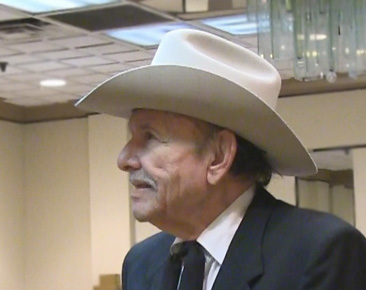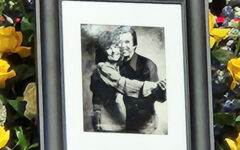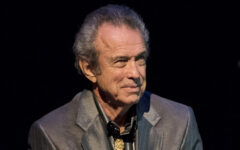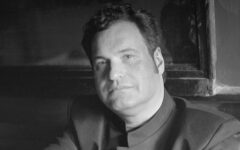
 Benjamin Franklin ‘Tex’ Logan Jr, best noted for his writing of the bluegrass standard, albeit a seasonal song, Christmas Time’s A-Comin’, passed away at the Morris Hills Center in Morristown, New Jersey, on Friday, April 24, 2015.
Benjamin Franklin ‘Tex’ Logan Jr, best noted for his writing of the bluegrass standard, albeit a seasonal song, Christmas Time’s A-Comin’, passed away at the Morris Hills Center in Morristown, New Jersey, on Friday, April 24, 2015.
Logan took after his father and soon learned to play the fiddle. However, he didn’t neglect his studies. He excelled as a scholar, earning a BS in electrical engineering at Texas Tech University, then Texas Technological College, in Lubbock, Texas, then studied for a BS in engineering at Massachusetts Institute of Technology (Cambridge, Massachusetts), where he earned an MS also.
Born in Coahoma, Howard County, Texas, on June 6, 1927, Tex Logan grew up enjoying ‘fiddlings’, evening jam sessions, hosted in the family home by Tex’s father, who was a respected old-time fiddler and fiddle collector in west Texas. Given this atmosphere, it is not surprising that the younger Logan became interested in playing that instrument.
Lack of progress in his learning led to lack of interest and his next musical chapter came when Logan began playing the trumpet, which he did from grade school through to high school.
Then one day he had a dawning realization that the secret to fiddling was having rhythm in the bow. So he retrieved his fiddle and persevered until, “I could kind of play Arkansas Traveller. That’s how I got going pretty good,” Logan once recalled of the event.
Logan then bought some used records from a juke-box supplier in neighboring Big Spring. Among them was the Bill Monroe recording of Katy Hill, featuring the super-charged fiddling of Tommy Magness. Logan’s excited response led to his younger brother Homer playing the record to waken Tex each school-day morning.
Typically, the Logan’s listened a lot to the Grand Ole Opry on the radio and the fiddlers that Tex Logan heard there, many of whom played with Bill Monroe, led to Logan’s affinity with what he called “mountain fiddling,” rather than any Texas style.
 Logan would play the fiddle around the house, accompanied by brothers Russell on guitar and Homer on mandolin.
Logan would play the fiddle around the house, accompanied by brothers Russell on guitar and Homer on mandolin.
He then befriended transplanted east Texas fiddler H M Hubbard and the duo went to fiddle socials together. Logan later recorded Jordan am A Hard Road to Travel, which he learned from Hubbard, who called it The Old Grey Goose.
At this point Logan’s pursuit of his electrical engineering degree at Texas Tech University meant that he had little time for playing the fiddle except when Hubbard visited him and when, at lunch-time, he attended the local drug-store to enjoy the music of the Drug Store Cowboys.
Upon graduation Logan accepted a position as research assistant at Massachusetts Institute of Technology. However, before heading east, Logan spent that summer (1946) working with Hoyle Nix’s western swing band. Nix and Logan loved fiddle breakdowns and they played twin-fiddle renditions of their favorite tunes at every one of their dance shows.
While at Massachusetts Institute of Technology (MIT) Logan would take any break from his research work to play at square dances, a popular student pursuit. He was assisted by fellow college student Dick Best, playing a twelve-string guitar.
Logan and Best found a spot on Boston’s local radio station WMEX, which led to them to being heard by popular Boston area country music act Jerry Howorth and Sky Snow, who, impressed with his fiddle playing, invited Logan to play with them full time. For the first time Logan was faced with the dilemma of mixing music with studies – and later with family and work. After a bit of negotiation, Logan was offered the opportunity to leave MIT, follow a musical path and later return to academia if music didn’t work out. So, off Logan went.
Jerry and Sky’s success didn’t last long as in spring 1948 they left the lucrative Boston area for Albany, New York, where they were effectively shut out, and in the summer of 1948 they disbanded.
Logan returned to west Texas to work in the oil fields and play music with Hoyle Nix.
Not long afterwards Logan moved to Wheeling, West Virginia, at the suggestion of Ralph Jones with whom Logan had worked when with Jerry and Sky. Logan was recruited by Red Belcher and the Kentucky Ridge Runners – hitherto just Everett and Bea Lilly. They worked on an early morning radio show as well as on the Wheeling Jamboree.
 Also at this time Logan played in the Coal River Valley Boys, an aggregation that featured banjo player Don Stover.
Also at this time Logan played in the Coal River Valley Boys, an aggregation that featured banjo player Don Stover.
The group recorded two songs; Kentucky is Only a Dream and the afore-mentioned The Old Grey Goose.
Later Logan joined Hawkshaw Hawkins and Big Slim, the Lone Cowboy who had teamed up to play on the Wheeling Jamboree.
However, Logan was finding that music wasn’t as lucrative as he had hoped and in February 1949 he returned to MIT as a research assistant.
Logan continued to play fiddle, but only around the Boston area, as he did with Frank and Pete Lane, the Lane Brothers.
During the summers of 1949, 1950 and 1951 Logan went back to Wheeling where he worked with Wilma Lee, Stoney Cooper and the Clinch Mountain Clan. While with the Coopers Logan recorded Ain’t Gonna Work Tomorrow, Legend of the Dogwood Tree, White Rose, Sunny Side of the Mountain and Stoney, Are you Mad at Your Gal? In all, from 1950 to 1952 Logan, playing fiddle, harmonica and piano, recorded 15 cuts with Wilma Lee and Stoney Cooper.
Although his music commitments were tough, Logan completed his studies and earned his Batchelor of Science degree from MIT in 1951.
That summer, his draft into military service imminent, Logan spent the summer working with Wilma Lee and Stoney Cooper once more. His last show with the Coopers was in October 1951 at a coliseum in Baltimore. Also on the bill were Bill Monroe and the Blue Grass Boys, Flatt & Scruggs, Cowboy Copas and Wayne Raney.
An admirer of Bill Monroe’s, Logan now had an opportunity to meet and talk with Monroe. While working with the Lilly Brothers, Logan had written a Christmas song, his signature song Christmas Time’s A-Comin’, with Monroe in mind. With the help of Buck Graves, Logan played and sang the song for Monroe, who agreed to record it.
Later Logan taught Monroe the song and arrangements were made for Logan to play the fiddle on the cut. Unfortunately, due to automobile trouble, Logan was unable to get to Nashville in time for the recording session. Later Monroe played the recording during a telephone call to Logan, who approved the performance.
Logan’s draft commitments were deferred as he went to do research on missile guidance systems at MIT.
Also, he managed to play some music, briefly with the Lane Brothers, the trio landing a spot on the Hayloft Jamboree on Boston’s Radio WCOP.
When Frank Lane was drafted in military service, Logan and Pete Lane went off to Raleigh, North Carolina, in search of Curly Seckler, a former Foggy Mountain Boy. They encountered Lester Flatt and Earl Scruggs whose then mandolin player Everett Lilly indicated that he was thinking of re-joining his brother Bea and suggested that Logan might want to play with the Lilly brothers.
 Unable to find Seckler and offer him a job with them, Logan and Lane returned to Boston. Shortly afterwards, Everett Lilly did quit playing with Flatt & Scruggs and he returned to Massachusetts, whereupon Logan, the Lilly brothers, Pete Lane and Don Stover formed the Confederate Mountaineers, the first bluegrass band in Boston.
Unable to find Seckler and offer him a job with them, Logan and Lane returned to Boston. Shortly afterwards, Everett Lilly did quit playing with Flatt & Scruggs and he returned to Massachusetts, whereupon Logan, the Lilly brothers, Pete Lane and Don Stover formed the Confederate Mountaineers, the first bluegrass band in Boston.
The band performed as many as seven nights a week at the Hillbilly Ranch and other clubs in the immediate area, and worked on the Hayloft Jamboree.
In 1956 he moved to northern New Jersey to work for Bell Laboratories, for whom he worked for most of his adult life. Also, he enrolled at Columbia University, New York City, to do a PhD course.
These and family commitments led to him stopping his involvement in music. This sabbatical lasted about three years.
In a summer 1959 visit to the Sunset Park, an open-air Country music venue in West Grove, Pennsylvania, he met former employees Wilma Lee and Stoney Cooper and sat in with them during their set. That weekend Mike Seeger introduced himself and indicated to Logan that he wanted him to play for a various artists’ album that Seeger was working on.
Later that year Logan cut Natchez Under the Hill and Katy Hill for the album Mountain Music Bluegrass Style.
Due to the attention that he received following the release of that album, in 1963 Logan was invited to perform at the prestigious Newport Folk Festival. Logan played with the New Lost City Ramblers and later Vanguard Records released an album including Logan’s playing of Jordan Am A Hard Road to Travel.
During the following year Logan recorded with the Charles River Valley Boys, a Boston-based bluegrass band that included Joe Val.
In 1965 he played with the Lilly Brothers and Don Stover at that year’s Newport Folk Festival and their rendition of Black Mountain Rag was included on another Vanguard Records LP.
Yet again Logan took a break from music, this time for about three years. In 1968 Logan attended Carlton Haney’s bluegrass festival at Berryville, Virginia, an event that he enjoyed to the extent that he re-joined the Lilly Brothers and Don Stover performing at many of the bluegrass festivals that had started up during the previous three years.
Logan was renowned for his wonderful parties, although lesser known was the fact that he was a great cook. His barbecue parties at his rather grand Madison, New Jersey, home were in honor of Bill Monroe and were attended by many other professional bluegrass musicians as well as some fans.
Julian ‘Winnie’ Winston described them thus …..
“When the food was well on its way to being digested, and night began to fall, everyone went inside to his spacious den, where they were treated to an hour-long show by Bill Monroe and his whole band. As the hour drew to a close, Bill often called others up to play, and the playing continued until daybreak.”
Logan developed a friendship with Bill Monroe and the Father of Bluegrass Music invited him to bring his barbecue to cook at Monroe’s June Bean Blossom festival. For nine years starting in 1969 Logan oversaw the Barbecue Bean Day, when he dished up a free meal of beans, onions and bread for the patrons.
He played the fiddle at the festival with any band that was happy to have him on board and, often he had his own show backed by the Blue Grass Boys.
Logan was never a de facto Blue Grass Boy, but his long-lasting friendship with Monroe suggests that he may well have been. They often played on stage together.
Also, Logan was a regular participant in the Annual Old-Time Fiddlers’ Reunion, a feature of Bill Monroe’s closing set at Bean Blossom, (although the music was more bluegrass than old-time, it has to be said), beginning in 1972.
About 1977 ex- Blue Grass Boy Peter Rowan showed up at Bean Blossom without a supporting band. Rowan, who already knew Logan, invited the fiddler to play with him.
This led to a more permanent involvement in 1978 as the duo formed a band called the Green Grass Gringos, a combination that included Lamar Greer, Barry Mitterhoff and Roger Mason. They recorded a few songs that appeared on a Peter Rowan album.







